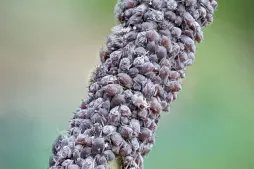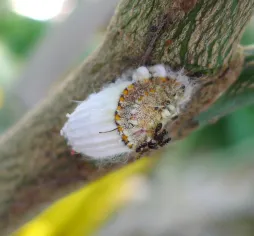Aloe aculeata, a spicy succulent
Aloe aculeata grows in South Africa, in the provinces bordering Mozambique and Zimbabwe. Like aristaloe aristata, it belongs to the Xanthorrhoeaceae family. Resistant to everything, this succulent has adapted to our temperate climates. In our latitudes, it is grown as an ornamental plant indoors and in the garden.
How to recognize Aloe aculeata?
In its first few years, Aloe aculeata appears as a fat, upright plant a few centimetres high. As it grows, it develops a broad trunk that can exceed a metre in height.
Aloe aculeata leaves measure between 30 and 60 centimetres. They are arranged in a rosette and arch skyward when the plant is young. They tend to droop over time. Green and fleshy, they are prickled with spines on both sides. Spines also hem the edges of the leaf blade at regular intervals. The brown spinules stand on pale-green protuberances.
In late spring and early summer, the plant develops an isolated flowering spike from the heart of the rosette. It supports orange or yellow flowers measuring two to four centimetres.
Although the Aloe genus has been credited with cosmetic virtues since antiquity - Cleopatra is said to have used aloe vera - the different varieties contain aloin, a toxic juice. So it's best to grow Aloe aculeata purely for its ornamental appeal!
Our maintenance tips
To grow aloe aculeata indoors, reproduce the conditions of their natural environment! Sun, warmth and little water. You can even take your succulent out to your windowsill or garden in summer.
Watering
Water only when the potting soil has completely dried out. Your plant prefers one copious watering to several less generous sessions. In this way, it can build up its water reserves and its roots won't rot. The substrate should remain moist for two days, the time it takes for your succulent to store water.
Place your Aloe aculeata in its pot in your sink or in a container such as a bowl or terrine. Water the soil until the water begins to run into the container. Continue until you reach the height of the drainage layer (about two centimetres). Once this limit has been reached, stop watering and replace your pot in its saucer. Empty stagnant water when it appears.
To determine whether your fat plant is thirsty, observe its leaves. If they become less fleshy, thin or hollow, it's time to give them a drink.
Spray
Aloe aculeata grow in arid regions and do not like humidity. No need to spray them.
Repotting
In spring, transfer your Aloe aculeata to a larger pot, so that it can continue to grow.
Aloe aculeata plants need repotting only when their roots begin to emerge from the pot.
In this case, choose an earthenware pot with a hole barely larger than the previous one (about 5 centimetres) : it will promote drainage.
Lay down a layer of clay balls or gravel before pouring in a substrate suitable for succulents. You can also mix a third of sand with your potting soil. Tamp regularly to eliminate air pockets and replant your Aloe aculeata.
Fertilization
You can stimulate the development of your plant during its growth phase, in spring and summer, with fertilizer.
You don't have to fertilize your plant to make it grow. However, if you want to stimulate its growth, you can give itfertilizer for cacti and succulents.
Prune
You can remove the dead leaves.
It's important not to prune the tips of the leaves. This will stop the growth of your Aloe aculeata.
It's important not to prune the tips of the leaves. This will stop the growth of your Aloe aculeata.
Plantation
Once the last spring frosts have passed, you can plant.
Where's the best place to plant your Aloe aculeata? A sunny spot at the top of a slope, to encourage rainwater drainage.
Dig a large hole to give the roots room to spread out. As for repotting, place a layer of gravel at the bottom, followed by a layer of substrate. Place your plant in the center and cover with soil, possibly enriched with leaf compost. Press down to eliminate air pockets and water.
Cutting
Cutting is carried out during the strong growth phase, generally in spring and early summer.
Take the shoots that form at the base of your Aloe aculeata. The larger they are, the greater the chances of success. Choose shoots with several leaves.
Cut off the new plant and its roots with a clean, sharp blade.
In a pierced terracotta pot, pour a bed of clay balls or gravel to optimize drainage.
Prepare a mixture of one-third potting soil, one-third garden soil and one-third sand. Pour it into your pot, on top of the drainage layer. Plant your cutting and tamp it down.
Place the pot in a room where the temperature is always above 18 degrees. The location should be bright and out of direct sunlight. You can, for example, place your cutting behind a curtained window.
To avoid drowning the roots, always check the condition of the substrate before watering: the surface must be dry.
Diseases / Threats
Information
| Family | Asphodelaceae - Asphodelaceae |
| Type | Aloe - Aloe |
| Species | Aloe aculeata - Aloe aculeata |
| Lifecycle | Perennial |
| Foliage | Evergreen |
| Exposures | |
| Substrats | |
| Planting methods |
In pots In tubs Planter |
| Categories | |
| Tags |
Rustic Toxic |
| Origin |
South Africa |
| Hardiness (USDA) | 9b |
| Leaf color |
|
| Flower colors |
|
Discover plants from the same family
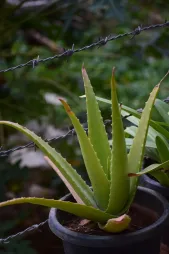
Aloe vera
Discover
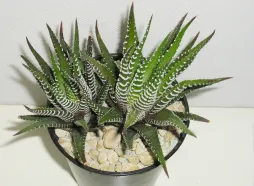
Haworthiopsis fasciata
Discover
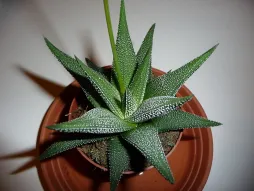
Haworthiopsis attenuata
Discover
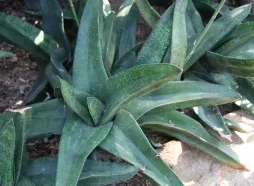
Gasteria acinacifolia
Discover










